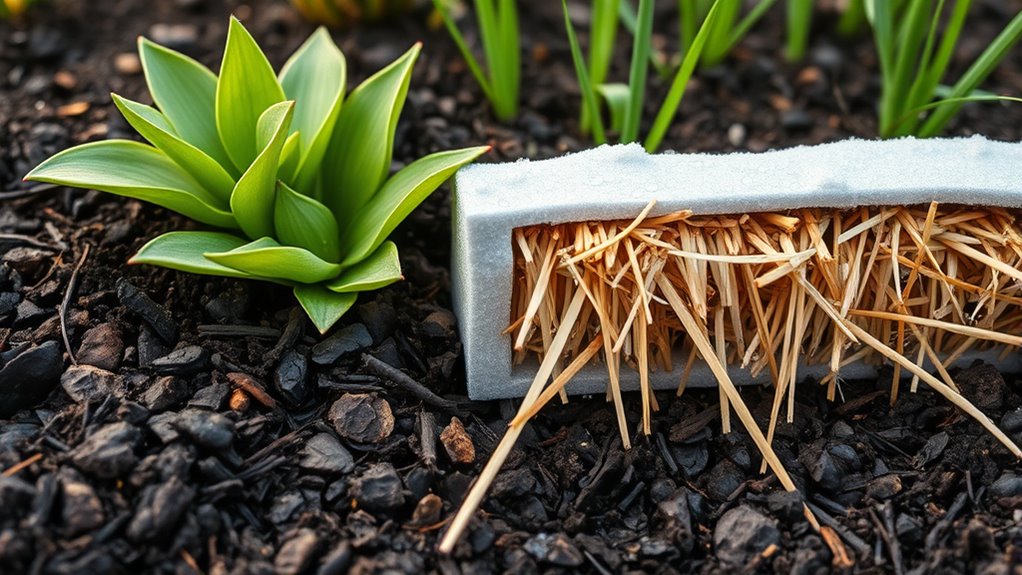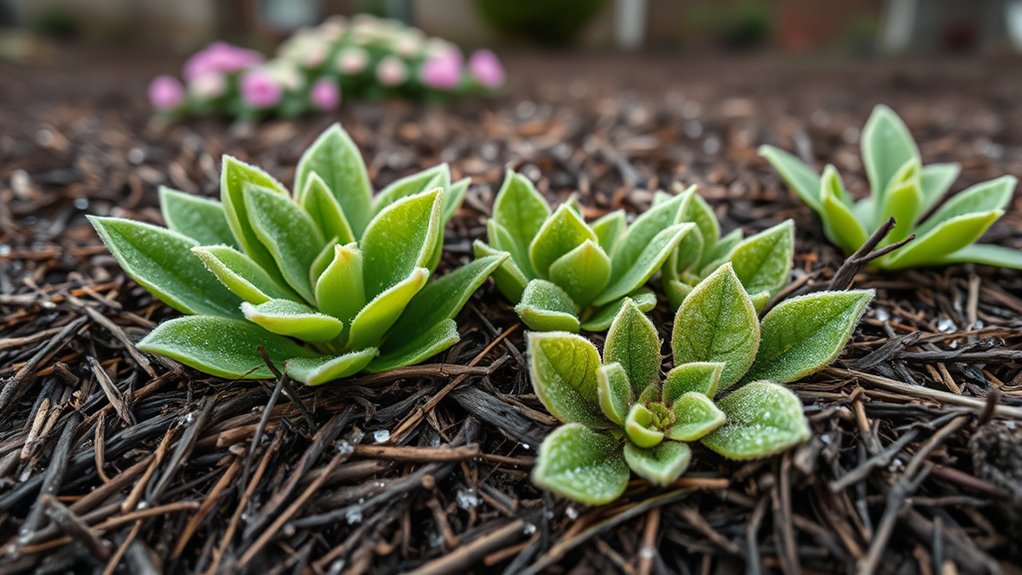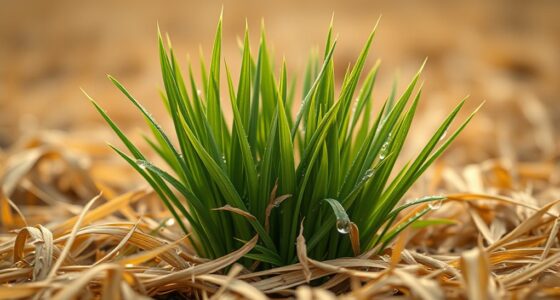To safeguard your perennial plants from frost, apply a layer of mulch such as straw, bark, or leaves around the roots to insulate from cold and retain moisture. Use coverings like burlap or row covers for added warmth, especially during harsh weather. Make certain your insulation is deep and secure, and reapply annually or after decomposition. If you want to learn more about effective techniques and timing, keep exploring for detailed tips and best practices.
Key Takeaways
- Apply organic or inorganic mulch evenly around plants in late fall to insulate roots and reduce frost damage.
- Use coverings like straw, burlap, or row covers based on plant vulnerability and climate conditions.
- Maintain mulch and coverings dry and secure, removing or adjusting them when temperatures rise.
- Deeply water plants before ground freezes to ensure hydration and prevent root stress during cold snaps.
- Regularly inspect and reinforce protective layers to adapt to changing weather and maximize frost resistance.
Understanding the Importance of Mulching and Insulation

Understanding the importance of mulching and insulation is key to protecting your perennial plants through seasonal changes. Mulching helps regulate soil temperature, keeping roots warm during cold snaps and preventing rapid temperature fluctuations. It also minimizes moisture loss, which is essential when the weather turns frosty. Insulation acts as an extra barrier, shielding plants from harsh winds and extreme cold that can damage delicate tissues. When you apply mulch properly, you give your plants a stable environment, reducing stress and encouraging healthy growth. Without proper mulching and insulation, your perennials are more vulnerable to frost damage, which can weaken or kill them. Recognizing the critical role these protective measures play allows you to prepare effectively and ensure your plants thrive year-round.
Choosing the Right Mulch Materials for Cold Protection

When selecting mulch for cold protection, you need to consider whether organic options like straw or bark or inorganic choices like plastic or gravel best suit your plants. These materials differ in their ability to regulate soil temperature, durability, and cost, so weigh what’s most important for your garden’s needs. Making the right choice ensures your perennials stay insulated and healthy through winter’s chill. Additionally, incorporating natural materials such as wood chips or linen can enhance the aesthetic appeal while providing effective insulation.
Organic vs. Inorganic Mulches
Choosing the right mulch material for cold protection involves weighing the benefits of organic and inorganic options. Organic mulches, like straw, wood chips, or leaves, decompose over time, enriching the soil with nutrients and improving structure. They also provide excellent insulation by trapping air and moisture, which can help shield plants from frost. Inorganic mulches, such as plastic or gravel, don’t decompose and tend to last longer. They reflect cold and heat, which may either protect or expose plants depending on your needs. Inorganic options are low-maintenance and prevent weed growth effectively. Your choice depends on factors like soil health, plant type, and your maintenance preferences. Consider how each mulch’s properties align with your goal of protecting perennials against frost damage. Additionally, selecting appropriate mulch materials can enhance overall plant resilience during cold weather.
Temperature Regulation Benefits
Selecting the right mulch material can considerably influence how well your perennials withstand cold temperatures. A suitable mulch acts as an insulating layer, reducing heat loss from the soil and maintaining a more stable root environment. Organic mulches like straw, wood chips, or compost are effective because they trap air, which provides natural insulation. Inorganic options such as gravel or rubber mulch can also help, but they generally don’t insulate as well as organic materials. The key is choosing a mulch that retains moisture and prevents rapid temperature fluctuations. Proper mulch application ensures your plants’ roots stay warmer during frosty nights, reducing the risk of damage. By understanding how different materials regulate temperature, you can select the best mulch to protect your perennials through cold spells. Effective insulation from mulch materials plays a crucial role in safeguarding plant roots during winter.
Material Durability and Cost
The durability and cost of mulch materials directly impact how effectively they protect your perennials during cold weather. You want a mulch that can withstand harsh winter conditions without breaking down quickly, ensuring continuous insulation. Organic mulches like straw or wood chips are affordable and readily available, but they may decompose faster, requiring more frequent replacement. In contrast, synthetic options like rubber or plastic mulches tend to last longer and resist decay, but they typically come with higher upfront costs. When choosing a material, consider your budget and how long you need the mulch to last. Investing in durable mulch might be more economical over time if it reduces the need for replacements and provides consistent frost protection. Balance initial expense with long-term performance to select the best option for your garden. Incorporating market research into your decision can help identify the most cost-effective and durable materials suited to your climate.
Techniques for Applying Mulch Effectively

To apply mulch effectively, you need to focus on proper layering, timing, and frequency. Guarantee you spread the mulch evenly at the right depth to protect your plants without suffocating them. Keep track of the best times to add or refresh mulch to maintain ideal insulation throughout the season. Regularly inspect the area and maintain a safe environment to prevent fire hazards from debris or accumulated material.
Proper Mulch Layering
Applying mulch correctly is essential for maximizing its benefits and protecting your perennial plants. To do this, spread a layer that’s about 2 to 4 inches thick, ensuring even coverage around the base without touching the stems. This prevents moisture buildup and rot while insulating roots. Use a variety of mulches suited to your plants, such as straw, bark, or compost. Proper mulch layering can also contribute to energy independence by reducing the need for additional watering and soil management.
| Mulch Type | Best Use |
|---|---|
| Organic | Improves soil as it decomposes |
| Inorganic | Long-lasting, minimal decay |
| Coarse Material | Prevents weed growth effectively |
Always remove mulch from the crown of the plant to prevent rot, and check regularly to maintain the proper layer thickness for ideal protection.
Timing and Frequency
When is the best time to add mulch? Ideally, you should mulch in late fall, after the first frost, to protect roots during winter. Applying mulch too early can trap moisture and encourage pests, while waiting too long may leave plants vulnerable. Reapply mulch annually or as needed, especially if it decomposes or shifts. In early spring, add a fresh layer to insulate emerging shoots and prevent frost damage. Avoid excessive layering; 2 to 4 inches is sufficient for insulation without suffocating plants. Check your mulch regularly, especially after storms or heavy rain, and replenish as necessary. Consistent timing ensures your plants receive ideal frost protection without excess moisture buildup or inadequate coverage. Proper mulch application techniques can further enhance your plants’ winter resilience.
Insulating Options for Vulnerable Perennials

Vulnerable perennials need extra protection as cold weather approaches, and choosing the right insulating options can make a significant difference in their survival. You can use various methods to shield these plants from frost, such as natural mulches, breathable fabrics, or specialized covers. Each option offers different benefits depending on the plant’s vulnerability and your climate. For example, straw mulch insulates roots effectively, while frost cloths protect foliage. To help you decide, consider this comparison:
| Insulation Type | Application | Effectiveness |
|---|---|---|
| Straw Mulch | Covering base and roots | Excellent for root warmth |
| Burlap Fabric | Wrapping plants or beds | Moderate frost protection |
| Plastic Covers | Creating mini-greenhouses | High, but less breathable |
| Row Covers | Light, floating covers | Good for delicate plants |
| Compost Layers | Deep mulching | Insulates and enriches |
Choose wisely based on your plant’s needs and local conditions. Additionally, understanding the role of contrast ratio can help you select covers that allow for optimal light transmission, ensuring healthy growth during colder months.
Timing and Maintenance of Cold Protection Measures

Timing and maintenance are key to ensuring your cold protection measures work effectively throughout the chillier months. You should prepare your plants before a frost hits, typically in late fall, and monitor weather forecasts regularly. As temperatures fluctuate, adjust your protection accordingly to prevent unnecessary stress or damage. Consistent checks help identify weak spots or gaps in insulation, allowing you to reinforce them early. Remember to remove or modify protective coverings when the weather warms to prevent overheating or moisture buildup. Proper timing and upkeep are essential for your plants’ survival and health. Additionally, understanding the signs of spoilage in lemon juice can help you avoid using compromised materials in your garden care routines. Keep mulch and protective layers dry and well-maintained.
Additional Tips for Ensuring Plant Survival During Winter

To maximize your plants’ chances of surviving winter, focus on enhancing their resilience through proper watering and soil management. Water deeply before the ground freezes, ensuring roots stay hydrated without becoming waterlogged. Avoid overwatering, which can lead to root rot. Use well-draining soil to prevent excess moisture buildup. Mulch around the plants to insulate roots and maintain consistent soil temperatures. Remove dead or diseased foliage to reduce pest and disease risks. Consider applying a slow-release fertilizer in fall to strengthen plant tissues. Protect vulnerable plants with additional covers during severe cold snaps. Regularly check for signs of stress or damage, and address issues promptly. Additionally, understanding plant hardiness zones can help you select the most suitable plants for your climate. These proactive steps improve your plants’ ability to withstand winter’s harsh conditions and promote healthier growth come spring.
Frequently Asked Questions
How Deep Should Mulch Be Applied for Optimal Frost Protection?
You should apply mulch about 2 to 4 inches deep for maximum frost protection. This depth provides enough insulation to shield your perennial plants from freezing temperatures without suffocating them. Make sure the mulch is evenly spread around the base of the plants, extending slightly beyond the root zone. Avoid piling mulch directly against plant stems, as this can cause rot. Proper mulching helps retain soil warmth and prevents frost damage effectively.
Can Mulching Harm the Roots of Perennials During Winter?
Think of mulching like wrapping a gift—you want to protect, not suffocate. Mulching can harm perennial roots if you pile it too deep or apply it too late in winter, trapping moisture and causing rot. To avoid this, keep mulch about 2-4 inches deep and make certain it’s not touching plant crowns. Proper mulching acts like a cozy blanket, shielding roots without smothering them.
Are There Eco-Friendly Insulation Options for Sensitive Plants?
Yes, there are eco-friendly insulation options for sensitive plants. You can use natural materials like straw, shredded leaves, or pine needles, which decompose safely and enrich the soil. These options provide excellent insulation while being sustainable. You might also consider burlap or jute fabric wraps, which are biodegradable and protect plants from frost. These eco-friendly choices help keep your plants warm without harming the environment.
How Do I Protect Potted Perennials From Frost Effectively?
You can protect potted perennials from frost effectively by moving them to a sheltered spot, like a garage or porch, during cold nights. Wrap the pots with insulating materials such as bubble wrap, burlap, or old blankets. Elevate the pots off cold ground, and avoid overwatering before frost. These steps create a barrier against cold and help maintain the plant’s warmth, ensuring their survival through chilly weather.
Is It Necessary to Remove Mulch After Winter to Prevent Pests?
Yes, you should remove mulch after winter to prevent pests from hiding and multiplying. Mulch acts like a cozy fortress for insects and rodents, turning your garden into a pest paradise if left too long. Once the danger of frost passes, clear away the mulch to expose pests and reduce their chances of overwintering. This simple step helps keep your garden healthy, vibrant, and pest-free all season long.
Conclusion
By mulching and insulating your perennials correctly, you substantially boost their chances of surviving harsh winters. Did you know that properly mulched plants can withstand temperatures up to 10°F lower than unprotected ones? That’s a huge difference in frost resilience! So, take the time to choose the right materials, apply them effectively, and maintain your protection measures. Your plants will thank you with lush growth come spring, proving that smart winter prep truly pays off.










